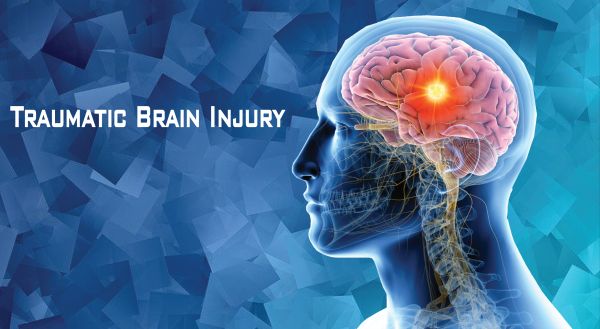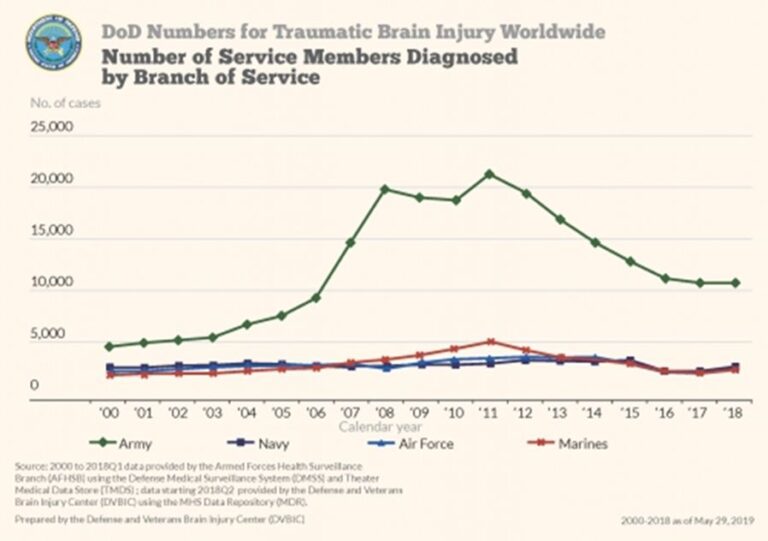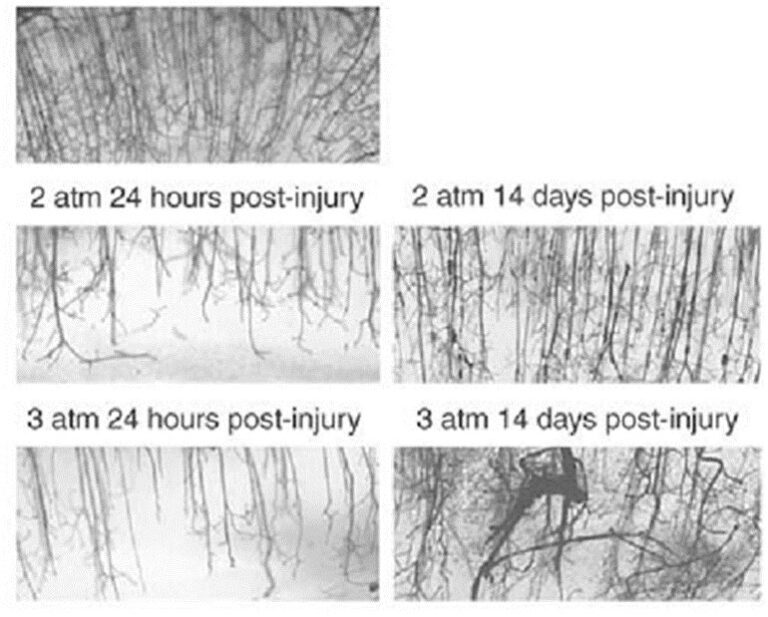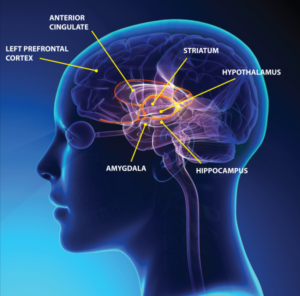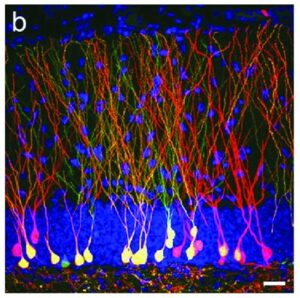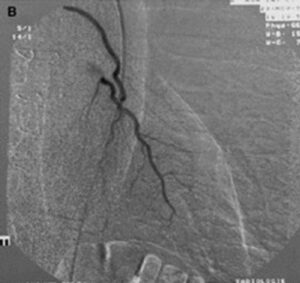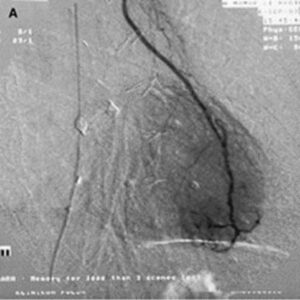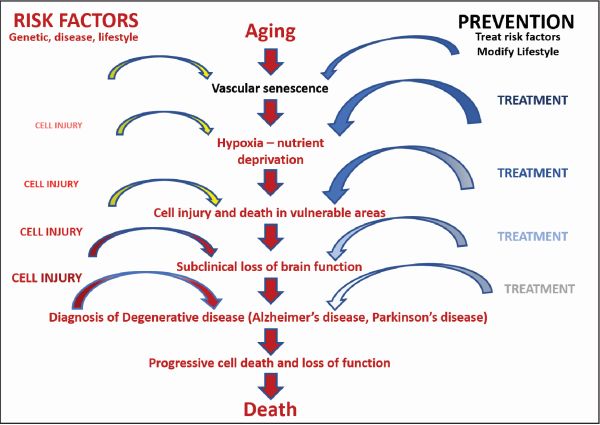
TRAUMATIC BRAIN INJURY
Treating Traumatic Brain Injuries (TBI) with Angiogenic Growth Factors
Traumatic brain injury (TBI) usually results from a violent blow or jolt or blast or bullet to the head. We believe that this trauma damages the microvasculature which causes a slow cascade of problems that become worse over time. We believe that based on evidence, we can use growth factors to repair this damage to the microvasculature and to the neurons.
TBI is prevalent in the United States. In military settings, blast exposure is the leading cause of TBI. For U.S. forces deployed to Afghanistan and Iraq estimates of the prevalence of TBI among returning service members range from 15.2% to 22.8%, affecting as many as 320,000 troops. As shown in Figure 1, there has been a precipitous rise in reported cases of military TBI.
Mild traumatic brain injury may affect your brain cells temporarily. More serious traumatic brain injury can result in bruising, torn tissues, bleeding and other physical damage to the brain. These injuries can result in long-term complications or death.
Traumatic brain injury can have wide-ranging physical and psychological effects. Some signs or symptoms may appear immediately after the traumatic event, while others may appear days or weeks later. Despite their frequency, the acute and long-term effects of TBI have been a relatively unexplored area of medical inquiry until very recently. Undoubtedly, the “invisible” nature of many TBIs, notably the lack of any external physical evidence of damage to the head or brain, has been a major factor contributing to the impression that these soldiers have an “inconsequential” injury. However, there is good evidence that many individuals develop persistent cognitive and behavioral changes, even after mild neurotrauma.
Depression is also a common problem after TBI. About half of all people with TBI are affected by depression within the first year after injury. Even more (nearly two-thirds) are affected within seven years after injury. In the general population, the rate of depression is much lower, affecting fewer than one person in 10 over a one-year period. More than half of the people with TBI who are depressed also have significant anxiety.
A recent report reveals that major depressive disorder (MDD) may be the most common and challenging mental health condition that patients encounter following a TBI with 53.1% of TBI patients in the study experienced MDD at least once in the first year after their injury. Another study showed that suicidal thoughts and attempts are also common reactions to TBI with 23% of the participants had thoughts of suicide, while 17% actually attempted suicide after their injury.
Understanding the effects of military-related TBI presents additional challenges not encountered in studies of neurotrauma seen in athletes or other at-risk groups. With sports-related brain trauma, the injury is generally dependent on the rules of engagement specific to the sport. With military-related TBI, trauma can occur in widely heterogeneous ways, including recreational activities, physical training practices, falls, motor-vehicle accidents, and exposure to explosive blasts. Injury from explosive blasts varies depending on the strength of the explosive and whether the injury occurs in an open field, near buildings or in a motor vehicle. Military TBI is also random and unpredictable, ranging from a single injury to many thousands of traumatic injuries over similar time periods depending on an individual's exposure to blasts and impacts.
Traumatic Brain Injury (TBI) Damages the Brain’s Microvasculature
The pathology behind traumatic brain injuries has been well studied and multiple animal models of TBI have been developed to examine the pathophysiology of this type of trauma. In general, rapid acceleration, deceleration, or rotational forces cause the brain to elongate and deform, stretching individual cells and blood vessels and altering membrane permeability. Although all cell compartments are affected by the injury, axons are especially vulnerable to shear injury given their relatively long length.
Striking microvascular disordering has also been consistently observed in animal models of TBI. As shown in Figure 2, rodents that have been subjected to experimental TBI and then allowed to recover showed a microvasculature that is less dense and more disordered. In these experiments, rodents were subjected to pressure-induced fluid percussion TBI, allowed to recover and then the brain microvasculature was examined 24 hours and 14 days post-injury.
On the top panel of Figure 2, a dense and well-ordered microvasculature can be seen in a control animal with a sham (fake) TBI. In animals injured with 2 atmospheres (middle panels) and 3 atmospheres (bottom panels) of pressure, depletion of the microvasculature is readily apparent at 24 hours post-injury injury. Upon recovery at 14 days the microvascular has been reestablished but it is less dense and more disordered than in the control animals. There is a significant depletion of the microvasculature at 24 hours post-injury and the relatively disordered re-growth of the microvasculature at 14 days post-injury.
From the above results, it could be anticipated that neurons would most likely be under-perfused in those areas of recovery which display a disordered microvasculature. This condition has been termed traumatic cerebral vascular injury and is thought to not only underlie the many deficits seen in TBI, but also in its chronic form, to actively participate in the pathogenesis of neurogenerative diseases including Alzheimer’s disease, Parkinson’s disease and chronic traumatic encephalopathy.
Brain Microvascular Disease and Major Depression
Although it is generally accepted that microvascular deficits contribute significantly to the pathogenesis of TBI, it is less well appreciated that Major Depressive Disorder (MDD)may also have brain microvascular abnormalities in its etiology. It is now well documented that chronic stress has a significant impact on the cellular integrity and function of certain brain areas, most notably the limbic structures which include the hippocampus, amygdala and prefrontal cortex (PFC), as shown in Figure 3. These areas of the brain communicate with each other and are vital to consolidating memory, decision making and emotional responses.
Numerous studies have demonstrated that chronic stress exposure results in reduced hippocampal volume and suppressed adult neurogenesis in the hippocampus. Parallel to these findings, a growing number of studies demonstrate that many of these stress-induced cellular changes can be reversed by antidepressant treatment. In contrast to the intensive efforts that have been made to reveal stress-induced molecular and cellular alterations of neurons, little attention has been paid to possible changes in vascularization, which is the major structure for supplying nutrition and oxygen to neurons in the limbic system.
The exact pathway for how stress influences the survival of injured neurons is unclear. It has been proposed that stress is harmful, because stress releases glucocorticoids which impair the capacity of neurons to survive. Another possibility, which has come from more recent studies, indicates that chronic stress may impair vascular supply and damage neurons in a process very similar to traumatic cerebral vascular injury which was noted above in the context of TBI. In these recent studies, careful analyses were conducted to examine possible changes in the vascularization of hippocampal tissue after exposure to chronic stress.
In an animal model of major depression, investigators showed a consistent decrease in the number of small capillaries which supply the hippocampus. As shown in Figure 4, there was a significant decrease in the number of capillaries throughout the entire hippocampus in animals that have a depressive disorder brought on by chronic psycho-emotional stress. It should also be noted that as mentioned above, stress results in the release of corticosteroids from the adrenal gland as part of the “fight or flight” syndrome. As corticosteroids are known to be very potent inhibitors of angiogenesis, these steroids could be contributing to the observed decrease in hippocampus capillaries following chronic stress and depression.
In this animal model of depression, five weeks of daily psycho-social stress resulted in about a 30% decrease in microvessel number in all hippocampal subareas. Such a dramatic change is likely to have a significant impact on the oxygenation and nutritional supply of the neurons in that area of the brain. Subsequent studies in this animal model of depression established that, indeed, this decrease in capillary number also resulted in a significant decrease in neurogenesis or new neuron formation in the hippocampus. By confocal microscopy, new neuron formation and their survival could be detected and quantified in the hippocampus, as shown in Figure 5.
On the panel on the left side of the figure 5, new neurons in the hippocampus can be visualized by confocal microscopy. This can be quantitated as shown in the panel on the right where it can be seen that stress inhibits neurogenesis (neuron proliferation and survival) in the hippocampus. Thus, these and other studies clearly demonstrate that microvascular dysfunction in the brain brought about by stress and depression can have a powerful impact on the proliferation and survival of neurons in the hippocampus, an area of the brain critically responsible for proper emotional and cognitive functioning of individuals. Although most of these recent studies have focused on the hippocampus, there is no reason not to suspect that a similar mechanism may also be in play in other emotional and decision-making centers of the brain, including the amygdala and the prefrontal cortex.
Human Fibroblast Growth Factor: A Potent Co-regulator of Angiogenesis and Neurogenesis and Its Role in Major Depression Disorders
In studies reported at the 2008 Annual Meeting of the American Heart Association on heart patients treated in an FDA-cleared Phase I clinical trial, FGF-1 stimulated the growth of new blood vessels in the hearts of patients damaged by severe coronary artery disease. This resulted in an improvement of clinical outcomes, including a decrease in anginal chest pain and increased exercise performance. Figure 6 shows the characteristic “blush” of newly formed blood vessels that is seen when FGF-1 is injected into the hearts of patients with coronary artery disease. These images are angiograms of a patient receiving a coronary bypass procedure who received an injection of either heat inactivated FGF-1 (control heart) or FGF-1. (from Schumacher 1989).
From observations, it has been noted that FGF-1 in positive data in animal models of stroke that FGF-1 is a potent neuroprotective agent. There are currently 18 members of the FGF family and 10 of these growth factors are expressed in the brain. FGF-1 and FGF-2 are ubiquitously expressed in the adult brain with the highest expression in the hippocampus and cortical areas. The prototypical receptor for FGFs, FGF receptor-1, is found mostly on neurons, although its expression has also been demonstrated on neural stem cells. This receptor has been shown to play a predominant role in both the development of the cortex and hippocampus, two key regions involved in the development of major depressive disorder.
A body of research has now established that the FGF family of growth factors can modify anxiety-like and depression-like behavior and appears to play a significant role in Major Depressive Disorder (MDD). This concept emerged from studies of postmortem brains of subjects who had died while suffering from severe clinical depression. MDD is the most debilitating mood disorder in the United States, accounting for the single greatest psychiatric cause of disability. A better understanding of the pathophysiology of this disease is acutely needed given the high rate of incidence of this disease (25% lifetime incidence of MDD), and that only a 33% response rate is seen in first line treatments for MDD.
The first link between the FGF family and depression came from “gene mining” studies done with brain autopsy specimens from subjects who died from major depression and revealed that members of the FGF family, including FGF-1, were significantly decreased in major depression.
These findings have since been extended to other brain regions and have led to a series of studies in animal models that have transformed the understanding of the role of the FGF family in depressive behaviors.
Animal studies were performed in models of depression-like behavior that more closely paralleled depression in humans. The animal models employed focused on the hippocampus, as postmortem studies pointed to this brain region as the most altered by MDD. Moreover, this is an area that is critical in the biology of ‘‘stress-related disorders,’’ including MDD, anxiety, and posttraumatic stress disorder (PTSD). For example, human brain imaging studies have shown that the volume of the human hippocampus decreases significantly in patients with PTSD, consistent with the view that this area is highly responsive to stress-related disorders.
FGFs can control the development and size of the hippocampus and it has been demonstrated that FGFs and their receptors are decreased in these animal models of depression. To ascertain the possibility that FGF could act as an “endogenous antidepressant”, FGF was directly administered into the brains of depressed adult rats and multiple tests of depression-like behavior established that FGF has demonstrable antidepressant properties. In addition, it was also shown that after FGF injection into the brain, specific markers of neurogenesis were up-regulated. As shown below in Figure 7, FGF injections resulted in a robust stimulation of the neurogenesis biomarker, nrk3 kinase protein, which is located within the dentate gyrus region of the hippocampus, an area important for memory retention and exploratory behavior.
Taken together, this body of research points to a critical role of the FGFs in mediating major depression. FGF-1, as the most potent and widely-acting member of the FGF family, and with its ability to co-regulate both angiogenesis and neurogenesis, would appear to be a good therapeutic candidate to test in brain disorders that are characterized by a disruption of the microvasculature resulting in underperfusion of brain neurons.
Conclusion
Wund believes that FGF-1 can benefit patients with debilitating neurodegenerative diseases, including TBI and Major Depressive Disorder. These diseases are unmet medical needs and we firmly believe that there is a strong body of evidence indicating that these degenerative diseases have as a primary initiating cause, dysfunction in the brain’s microvasculature. Our thinking is reflected in Figure 8, where “vascular senescence” can also mean vascular dysfunction or vascular disorder. We believe that FGF-1, as a stimulator of angiogenesis in the microvasculature, could be given early in these brain disorders, to potentially prevent the downward spiral to neuron cell injury and death. Even if given later in the disease progression, we believe that FGF-1, with its ability to co-regulate both angiogenesis and neurogenesis, could also be of possible benefit in later stages of the disease process.
Given our current knowledge, the word “Aging” in figure 8 could be replaced with the words “Trauma” or “Stress” and the same downward spiral would be seen with TBI or Major Depressive Disorder. It is our hope our work could lead to an improvement in mood and function in these patients, with an accompanying reduction in suicidal thoughts and actions.
Research Papers and additional reading:
1. The FGF family: biology, pathophysiology and therapy. Beenken A and Mohammadi M. Nat Rev Drug Discov 2009; 8: 235-253. https://www.ncbi.nlm.nih.gov/pubmed/19247306
2. Quantitative Changes in Hippocampal Microvasculature of Chronically Stressed Rats: No Effect of Fluoxetine Treatment. Czeh B et al. Hippocampus 2010; 20:174–185. https://www.ncbi.nlm.nih.gov/pubmed/19330847
3. Neurogenesis in the adult human hippocampus. Eriksson et al. Nature Medicine 1998; 4: 1313-1317. https://www.ncbi.nlm.nih.gov/pubmed/9809557
4. Fibroblast growth factors and their receptors. Gaizie Z, Kinsella AR, Smith JA. Biochem Cell Biol 1997; 75:669-685. https://www.ncbi.nlm.nih.gov/pubmed/9599656
5. Alzheimer’s Disease Neuroimaging Initiative. Early role of vascular dysregulation on late-onset Alzheimer’s disease based on multifactorial data-driven analysis. Iturria-Medina Y, R.C. Sotero, P.J. Toussaint, J.M. Mateos-Perez, A.C. Evans & The Nature Communications 2016, 7:1-14. https://www.nature.com/articles/ncomms11934
6. Cerebral Vascular Injury in Traumatic Brain Injury. Kenney K et al. Experimental Neurology 2016; 275:353-366. https://www.sciencedirect.com/science/article/abs/pii/S0014488615300066
7. Military-related traumatic brain injury and neurodegeneration. McKee AC and Robinson ME. Alzheimer’s Dement. 2014; 10: S242–S253. https://www.ncbi.nlm.nih.gov/pubmed/24924675
8. The spectrum of disease in chronic traumatic encephalopathy. McKee AC et al. Brain 2013; 136:43-64. https://www.ncbi.nlm.nih.gov/pubmed/23208308
9. Traumatic brain injury results in acute rarefication of the vascular network. Obenaus A et al. Nature Scientific Reports 2017:239. https://www.ncbi.nlm.nih.gov/pubmed/28331228
10. An analysis of regional microvascular loss and recovery following two grades of fluid percussion trauma: a role for hypoxia-inducible factors in traumatic brain injury. Park E et al. J Cereb Blood Flow Metab 2009; 29:575-584. https://journals.sagepub.com/doi/10.1038/jcbfm.2008.151
11. Induction of Neoangiogenesis in Ischemic Myocardium by Human Growth Factors. First Clinical Results of a New Treatment of Coronary Heart Disease. Schumacher B, P Pecher, BU von Specht, TJ Stegmann: Circulation 1998; 97:645-650. https://www.ahajournals.org/doi/10.1161/01.CIR.97.7.645
12. Thomas K, Rios-Candelore M, Gimenez-Gallego G, et al. Proc Natl Acad Sci USA. 1985; 82:6409-13. https://www.ncbi.nlm.nih.gov/pubmed/2413439
13. The War Within: Preventing Suicide in the US Military. Tanielian T and Jaycox L (editors). RAND Corporation, 2011. https://www.rand.org/content/dam/rand/pubs/monographs/2011/RAND_MG953.pdf
14. Midlife vascular risk factors and Alzheimer’s disease: evidence from epidemiological studies. Tolppanen AM, Solomon A, Soininen H, Kivipelto M. J Alzheimer’s Dis 2012; 32: 531–40. https://www.ncbi.nlm.nih.gov/pubmed/22842867
15. The Fibroblast Growth Factor Family: Neuromodulation of affective behavior. Turner CA, Watson SJ, Akil H: Neuron 2012, 76:160-174. https://www.ncbi.nlm.nih.gov/pmc/articles/PMC3476848/
16. Dysregulation of the fibroblast growth factor system in major depression. S. J. Evans, et al. Proc Natl Acad Sci U S A. 2004 Oct 26; 101(43): 15506–15511. https://www.ncbi.nlm.nih.gov/pmc/articles/PMC523463/

